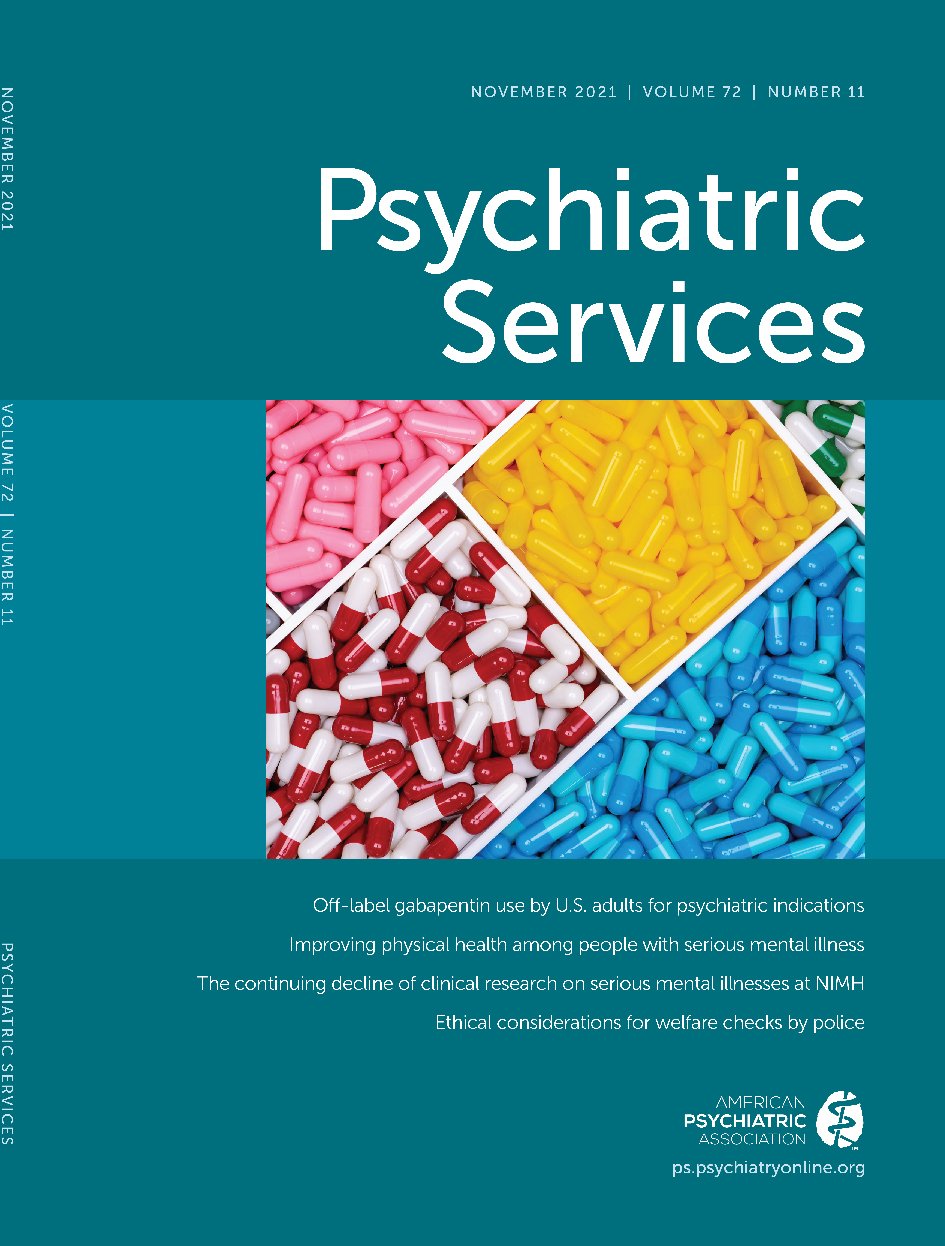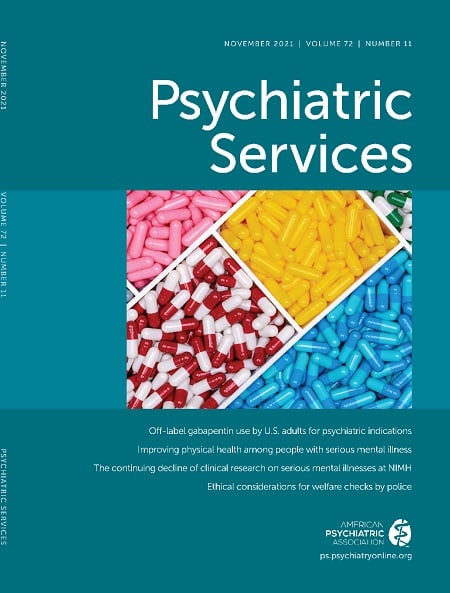Approximately 100,000 youths and young adults in the United States experience a first episode of psychosis each year (
1). Onset of nonaffective psychosis typically occurs at ages 15–25, interrupting developmental milestones that include independent living, educational attainment, and vocational planning (
2). Specialized early intervention services after onset of nonaffective psychosis, however, have the potential to improve functional outcomes for people with these disorders. In the United States, such specialized early intervention services are typically called “coordinated specialty care.” These services vary widely across programs, but generally include access to a set of evidence-based practices (i.e., medication management, psychotherapy, substance use treatment, peer support, case management, family education and support, and supported employment and education services) offered in a team-based approach (
2). Early intervention services are designed to improve functional recovery, reduce the duration of untreated psychosis, and improve symptoms. Early intervention services have been associated with substantial improvements in outcomes during treatment, including treatment continuation, hospitalization, symptom severity, and school and/or work participation (
3).
However, the extent of the sustainability of the gains after services end is a complex issue. There is limited data on the long-term effectiveness of early intervention in the United States because of the relative recency of the use of such services here. A number of international studies (
4–
6) have found that initial gains during early intervention treatment attenuate over time. However, a few studies have found that intervention groups continued to do better than historical control groups for some outcomes. A U.K. study (
7) found higher treatment engagement in an early intervention group at 5 years after treatment initiation, versus a historical control group, but found no differences in hospitalization rates. An Australian study (
8) found greater symptom reduction and improved course of illness in an early intervention group versus a historical control group at 8 years after treatment initiation. Likewise, meta-analyses have found greater relapse prevention (
9) and remission and recovery (
10) for intervention groups versus control groups. In response to the limited evidence of sustainability in gains, programs, including in Hong Kong, Canada, and Denmark, have extended early intervention services, with mixed results. A trial of a 1-year extension of Hong Kong’s Early Assessment Service for Young People with Early Psychosis (EASY) program (
11) found improvement in symptoms and treatment engagement compared with no extended treatment. A trial of a 3-year extension of an early intervention program in Montreal (
12) found that the extended treatment had a positive impact on symptom remission. A trial of a 3-year extension in Denmark’s OPUS II study (
13) found higher rates of engagement and satisfaction with treatment, but no differences in symptoms, between the early intervention and control groups.
Because early intervention services are newer in the United States than in some other countries (
2), even less is known about the long-term sustainability of initial benefits in the United States. Once early intervention services end, clients may not transition to community-based treatment, and if they do, the transition into the mainstream health care system can be challenging, with community-based treatment typically being less coordinated than what may be found in coordinated specialty care settings and lacking specialized competencies in treating psychosis. Moreover, services may not be as recovery focused as early intervention services, and specialized services, such as peer support and education and employment support, may not be readily available; in particular, private insurers may be especially unlikely to cover these services.
This study examined postdischarge hospitalization and emergency room (ER) usage among Medicaid enrollees from OnTrackNY, New York State’s early intervention program for individuals experiencing a first episode of nonaffective psychosis. On average, about half of OnTrackNY participants have been enrolled in Medicaid; in June 2020, 53% of participants were enrolled. The OnTrackNY program has established improvements in outcomes, such as hospitalization, work and/or school participation, symptoms, and social and occupational functioning, during treatment (
14,
15). This report focuses on postdischarge outcomes.
Methods
The OnTrackNY program serves individuals ages 16–30 who have experienced nonaffective psychosis for at least 1 week but less than 2 years (
16). Participants receive a set of coordinated, team-based services that include the entire early intervention package described above. The program sites across the state operate in a variety of settings, including community agencies, community and academic hospitals, and state-operated facilities. The program aims to provide treatment for an average of 2 years, with the duration of treatment varying according to client needs. The program has developed a rich set of deidentified clinical data collected every 3 months during their participation (
17).
This study used additional deidentified data from Medicaid claims data linked with OnTrackNY clinical program data provided by the New York State Office of Mental Health. The New York State Psychiatric Institute Institutional Review Board determined that this analysis of deidentified data was not human subjects research.
We examined clients who were continuously enrolled in OnTrackNY for at least 6 months and were covered by Medicaid in the 6 months prior to program entry, the 6 months prior to OnTrackNY discharge, and the 6 months after OnTrackNY discharge. This method allowed us to compare rates of hospitalization and ER use at these three time points (
18). We examined participants who were enrolled from October 2013 through June 2019; 138 participants from the 22 program sites that were active during the study met inclusion criteria. This sample was composed of all participants who were discharged, regardless of the circumstances of discharge (i.e., both program-initiated and client-initiated discharges), and included those who may have achieved their goals for treatment and those who decided to leave the program without having achieved their goals.
The dependent variables were the numbers of inpatient hospitalizations, inpatient days, and ER visits in each 6-month period and included hospitalizations from all causes (i.e., due to psychiatric or medical conditions). The model controlled for client demographic characteristics (age, gender, race-ethnicity) and months of OnTrackNY enrollment. Program site was not significant in these analyses and was removed from the model to conserve degrees of freedom.
Negative binomial random effects models were used to assess trends in hospital and ER use over time. Goodness-of-fit tests (Akaike information criterion and Bayesian information criterion) were used to compare linear, Poisson, and negative binomial models; negative binomial models achieved the best fit. Pairwise comparisons were used to examine predictive margins across the time points. Analyses were conducted by using Stata SE, version 14.2.
Results
Of the 138 participants at baseline, 105 (76%) were male; 21 (15%) were non-Hispanic White, 55 (40%) were non-Hispanic Black, 44 (32%) were Hispanic, 12 (9%) were Asian, and six (4%) were of another race-ethnicity or were missing data for race-ethnicity. Because of the small numbers, the categories of Asian, other, and mixed race-ethnicity were combined (in a sensitivity analysis, neither Asians nor those with other or missing race-ethnicity were significant as separate categories). The mean±SD age at admission was 20.9±3.3, and the mean number of months of OnTrackNY enrollment (given that enrollment of at least 6 months was required for inclusion in the sample) was 19.9±11.0. In the pre-enrollment period, participants had a mean of 0.80±0.88 inpatient visits, 12.88±19.27 inpatient days, and 1.45±1.93 ER visits. This use decreased to a mean of 0.26±0.65 inpatient visits, 3.70±10.50 inpatient days, and 0.88±3.26 ER visits in the 6 months before discharge from OnTrackNY and a mean of 0.30±0.62 inpatient visits, 4.97±11.95 inpatient days, and 0.83±1.42 ER visits in the 6 months after discharge.
Table 1 presents the results of the regression analyses. The number of hospital inpatient visits significantly declined during OnTrackNY participation (β=–1.23, standard error [SE]=0.22, p<0.001), did not significantly change in the first 6 months after discharge (β=0.19, SE=0.26, p=0.48), and remained significantly lower than before OnTrackNY program entry (β=–1.05, SE=0.20, p<0.001). Similar patterns were observed for inpatient days and total ER visits. Overall, participants who were non-Hispanic Black had more hospitalizations (β=0.60, SE=0.29, p=0.04) and more inpatient days (β=0.87, SE=0.31, p=0.01) compared with White, non-Hispanic participants; Hispanic participants also had more inpatient days (β=0.71, SE=0.32, p=0.02) than White non-Hispanic participants. Participants who were older at admission had fewer ER visits (β=–0.05, SE=0.03, p=0.04). Hospitalization and ER outcomes did not significantly vary by gender or months in OnTrackNY. In a sensitivity analysis, hospitalization and ER outcomes were dichotomized and analyzed by using logistic regression; results were similar.
Discussion
Consistent with previous studies (
5) of early intervention services for young people with recent-onset psychosis and prior studies (
14,
15) of OnTrackNY outcomes, rates of hospitalization and ER use declined during OnTrackNY participation. Notably, hospitalization rates have been shown to decrease during the first 3 months after OnTrackNY enrollment and remain relatively steady thereafter (
14); the present study showed that these rates did not significantly increase during the first 6 months after discharge. To our knowledge, this study is the first to examine postdischarge outcomes among a U.S. sample of coordinated specialty care clients and helps shed light on client trajectories during and after these services.
OnTrackNY participants served by Medicaid may differ from the full OnTrackNY population because Medicaid recipients are more likely to be economically disadvantaged. Notably, only 15% of this sample was non-Hispanic White, although about 24% of participants ever served by OnTrackNY are non-Hispanic White. The differences in outcomes observed across racial-ethnic groups were identified during the pre-OnTrackNY enrollment period. Future analyses should further examine the impact of racial-ethnic disparities.
Study limitations should be noted. First, we used observational data from one early intervention program in one U.S. state; the sample was further limited by inclusion criteria of enrollment in Medicaid. Additionally, the period after discharge was limited to 6 months. Future studies should examine larger samples, longer postdischarge periods, and additional outcomes and predictors. This study did not have a control group, and it is possible that hospitalizations may naturally attenuate over time (e.g., regression to the mean), particularly because many participants were referred to the program from hospital settings. Moreover, if there was an effect of treatment, there is no way to know whether it was due to the OnTrackNY program or if other interventions would have been similarly effective. Future analyses should also include data on samples beyond Medicaid enrollees, which was not possible in this analysis. For example, OnTrackNY helps clients who are uninsured at program entry apply for Medicaid; these individuals were not included because it was not possible to analyze pre-enrollment hospitalization rates for those not previously enrolled in Medicaid.
Conclusions
Although more research is needed, particularly of larger populations and over a longer time frame, this study provides an initial indication that decreases in hospitalization and ER usage are maintained and do not significantly increase in the first 6 months after discharge from OnTrackNY.

